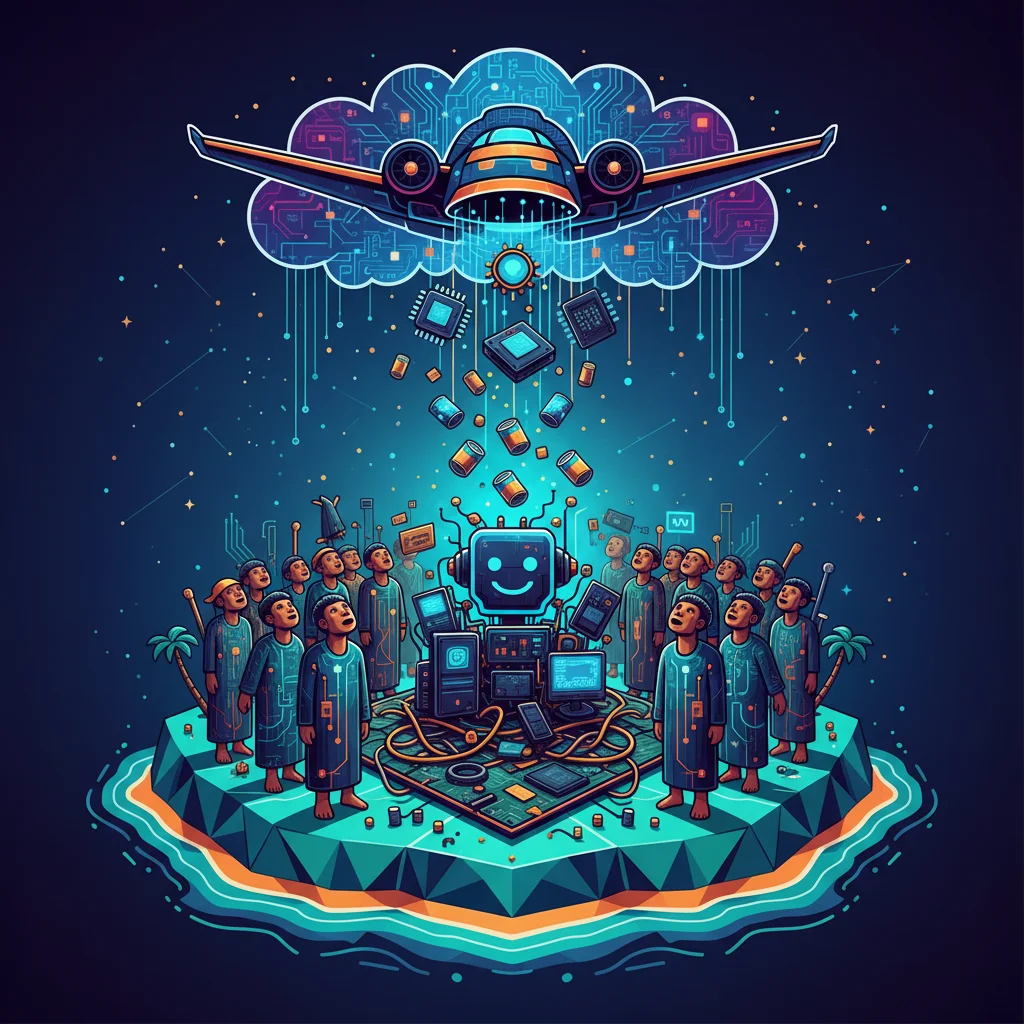
Is the AI Boom a High-Tech Cargo Cult?
Picture this: It’s the end of World War II on a remote Pacific island. For years, islanders watched in awe as military cargo planes descended from the sky, delivering unimaginable riches—canned goods, tools, and modern marvels. When the war ended and the planes stopped coming, some islanders tried to lure them back. They meticulously built life-sized replicas of airstrips from bamboo, carved wooden headphones, and lit signal fires, perfectly mimicking the rituals they had observed. They believed that if they copied the form, the magical results would follow. This was the birth of the “cargo cult.”
Now, fast forward to today. Look at the world of artificial intelligence. Companies are spending breathtaking sums on NVIDIA GPUs, pouring billions into cloud infrastructure, and hiring expensive machine learning engineers. They are building the modern equivalent of bamboo airstrips and wooden control towers. The question, as posed in a sharp analysis by the Financial Times, is a sobering one: Are we in the midst of a massive AI cargo cult?
Are we just mimicking the rituals of tech giants, hoping that magical “AI planes” will land and shower our businesses with productivity and profit? The evidence suggests we might be.
The Great AI Spending Spree: All Ritual, No Reward?
The numbers are staggering. The race to achieve artificial general intelligence has ignited an investment frenzy. Tech giants and startups alike are locked in an arms race for computational power, creating a demand so fierce that it has propelled Nvidia to a multi-trillion-dollar valuation. Everyone is buying the “shovels” for the AI gold rush, but very few have found any actual gold.
This is the core of the cargo cult problem: the belief that possessing the tools of innovation is the same as innovating. A company can have the most advanced AI models and the most powerful servers, but if they are simply layering this technology on top of broken, inefficient, or outdated business processes, they’re just creating a very expensive, very fast version of their old problems.
The real magic of a transformative technology like AI isn’t in the technology itself, but in how it enables us to fundamentally rethink *how* we work. It’s not about using AI to answer customer service emails 10% faster; it’s about creating a system where those customer issues never arise in the first place. It’s a distinction between simple automation and true transformation.
The .5 Billion Eye in the Sky: How One Startup is Fusing Satellites and AI to See the Unseen
The Productivity Paradox Returns
This isn’t the first time we’ve seen this movie. In the 1980s and 90s, economists were baffled by the “productivity paradox.” Companies were spending fortunes on computers, but national productivity statistics barely budged. As economist Robert Solow famously quipped, “You can see the computer age everywhere but in the productivity statistics.”
Why? Because it took nearly two decades for businesses to move beyond using computers as digital typewriters and filing cabinets. The real gains came when they re-engineered their entire supply chains, inventory systems, and communication workflows around the new capabilities that networked computing offered. The technology was just the catalyst; the real work was in changing the business itself.
AI is a classic general-purpose technology, much like the steam engine, electricity, or the internet. These technologies don’t come with an instruction manual for success. Their value is only unlocked through relentless experimentation, process re-engineering, and a willingness to abandon old ways of working. Simply buying more SaaS licenses or spinning up more cloud instances isn’t a strategy—it’s just a shopping list.
From Cargo Cult to Real Value: A Strategic Blueprint
So, how do businesses, from nimble startups to established enterprises, avoid the cargo cult trap? It requires shifting focus from the *what* (the technology) to the *why* and *how* (the business problem and the new process).
Here’s a comparison of the two approaches:
| Aspect | The Cargo Cult Approach (Mimicry) | The Strategic Approach (Mastery) |
|---|---|---|
| Primary Goal | “We need an AI strategy.” Deploy AI for the sake of having it. | “We need to solve X business problem.” Use AI as a tool to achieve a specific outcome. |
| Investment Focus | Acquiring technology: GPUs, models, cloud credits. | Developing people and processes: Training teams, redesigning workflows. |
| Implementation | Layering AI on top of existing, unchanged processes. | Re-engineering business processes from the ground up with AI capabilities in mind. |
| Metric for Success | Activity-based: “We launched 5 AI features.” | Outcome-based: “We reduced customer churn by 15%.” |
| Organizational Role | AI is isolated in a siloed “innovation lab” or R&D team. | AI is a core competency, integrated across all business functions. |
Steps to Build a Real Airport, Not a Bamboo One
- Start with the Problem, Not the Tech: Forget about large language models for a moment. What are the most inefficient, costly, or frustrating processes in your organization? What are the biggest unsolved problems for your customers? Start there. Only then should you ask, “Could machine learning or automation help solve this in a fundamentally new way?”
- Embrace Vertical Integration: The biggest wins won’t come from generic, off-the-shelf AI. They will come from AI that is deeply integrated with your proprietary data and unique business workflows. This requires a combination of technical programming expertise and deep domain knowledge. Your subject matter experts are just as important as your AI engineers.
- Prepare for Organizational Surgery: True AI integration is invasive. It changes job descriptions, reporting structures, and the very flow of information. You can’t just bolt on an AI co-pilot and expect everything to change. It requires a mandate from the top down to challenge sacred cows and redesign how work gets done. As one venture capitalist noted, the current wave of AI spending is “a tax on unimaginative management.”
- Prioritize Data and Cybersecurity: An AI model is only as good as the data it’s trained on. The unsexy work of building clean, accessible, and secure data pipelines is the true foundation of any successful AI initiative. Hasty implementation without robust cybersecurity protocols can also open up entirely new attack vectors, turning a potential asset into a massive liability.
Cracking the Code: How India is Building an AI to Unite a Nation of 22 Languages
The Future Belongs to the Architects, Not the Acolytes
The promise of artificial intelligence is immense and undeniable. It has the potential to reshape industries, redefine productivity, and unlock human potential in ways we are only beginning to imagine. But the technology will not deliver that future on its own. It won’t magically descend from the sky just because we perform the right rituals and spend enough money.
The current investment bubble feels a lot like the dot-com boom of the late 90s. There was a frenzy of investment, a lot of hype, and a painful crash. But after the dust settled, the companies that survived and thrived—the Amazons, the Googles—were the ones that used the internet to build entirely new kinds of businesses. They didn’t just build websites for their brick-and-mortar stores; they built digital-native empires.
The same will be true for AI. The enduring winners will not be the companies that simply buy the most AI, but those that use it to become fundamentally better, smarter, and more efficient organizations. It’s time to stop building bamboo airstrips and start designing the airports of the future.
Beyond the Code: What Tech Startups Can Learn from Indie Video Games

